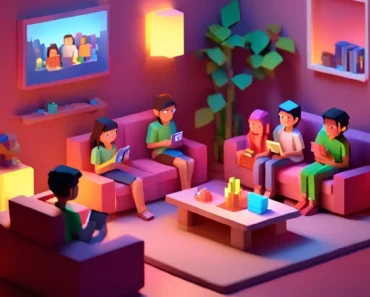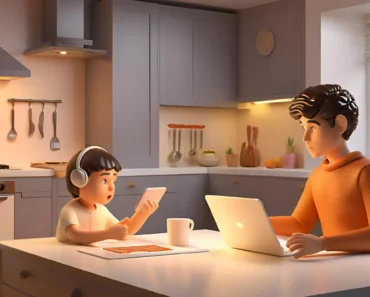What Are Screen Time Rules?
Screen Time Rules are guidelines families set to manage device usage, including smartphones, tablets, computers, and TVs. These rules often limit daily screen time, restrict certain apps or content, and designate tech-free zones or hours, like during meals or before bed. In the U.S., 70% of parents with kids under 12 use parental controls or time limits, per a 2024 Pew Research study, reflecting a growing focus on digital wellness.
These rules aim to balance technology’s benefits, like educational apps, with its risks, such as reduced focus or sleep issues. For example, the American Academy of Pediatrics suggests no screens for kids under 18 months (except video chats) and 1–2 hours daily for ages 2–5. For older kids, rulesilibre
Benefits of Screen Time Rules for Families
When implemented well, Screen Time Rules offer significant advantages for U.S. families, fostering healthier habits and stronger connections.
Improved Focus and Productivity
Limiting screen time helps kids and parents stay focused. A 2023 study found that excessive screen use reduces attention spans in 60% of children aged 8–12. Rules like capping recreational screen time at 2 hours daily encourage kids to engage in schoolwork or creative play, boosting productivity.
Better Sleep Quality
Screens emit blue light, which disrupts melatonin production and sleep. A 2024 report noted 75% of U.S. teens experience sleep issues linked to late-night device use. Rules banning screens an hour before bed improve sleep quality for the whole family.
Stronger Family Bonding
Screen Time Rules create space for real-world interaction. Families who enforce tech-free dinners report 20% more meaningful conversations, per a 2023 survey. This strengthens relationships and emotional well-being.
Enhanced Digital Wellness
Rules teach kids to use tech intentionally, not compulsively. By modeling balanced habits, parents help kids develop self-control, reducing risks of digital addiction noted in 25% of U.S. teens in 2024 studies.
These benefits make Screen Time Rules a powerful tool for creating healthier, more connected households when applied consistently.
Read Also: Parenting Gen Z: Why Old-School Rules Fail
Challenges of Enforcing Screen Time Rules
Despite their benefits, Screen Time Rules often spark battles in U.S. homes. Understanding these challenges helps families address them effectively.
Resistance from Kids
Kids often push back against limits, especially teens who see screens as social lifelines. A 2024 survey found 65% of U.S. parents report arguments over screen time with kids aged 13–17. This resistance can strain parent-child relationships.
Parental Inconsistency
Parents struggle to enforce rules consistently. A 2023 study noted 40% of parents admit to bending rules due to fatigue or busy schedules, undermining their effectiveness.
Tech’s Pervasiveness
With 95% of U.S. households owning smartphones, per 2024 data, screens are everywhere. Schools increasingly integrate tech, with 80% of students using devices for learning, making it hard to draw clear boundaries.
Parental Screen Habits
Parents’ own tech use can weaken rules. A 2024 report found 70% of U.S. parents spend 3–4 hours daily on screens, setting a conflicting example for kids.
These hurdles show that Screen Time Rules require commitment and clear communication to succeed.
Strategies for Effective Screen Time Rules
– Use Parental Controls: Leverage tools like Apple’s Screen Time or Google Family Link to monitor and limit usage. These block apps or set time caps automatically.
– Model Healthy Habits: Parents should limit their own screen time to 2–3 hours daily, showing kids balanced tech use. Put phones away during family time.
– Create Tech-Free Zones: Ban devices in bedrooms and at the dinner table. This promotes sleep and conversation, with 80% of families reporting better bonding, per 2023 data.
– Encourage Alternatives: Offer activities like board games, sports, or reading to replace screen time. A 2024 study found kids with diverse hobbies use screens 30% less.
These steps help families make Screen Time Rules a boon, not a battle, fostering balance and connection.
Conclusion: Making Screen Time Rules Work
Building a Balanced Digital Home
Screen Time Rules hold immense potential for U.S. families in 2025. They boost focus, improve sleep, strengthen bonds, and promote digital wellness when done right. Challenges like kid resistance, parental inconsistency, and tech’s pervasiveness can make enforcement tough, but clear rules, parental controls, and modeling healthy habits turn battles into benefits. By setting boundaries and encouraging alternative activities, families create a balanced environment where technology enhances life without dominating it. Screen Time Rules, when thoughtfully applied, empower families to thrive in a digital world, fostering connection and well-being.
Frequently Asked Questions About Screen Time Rules
What are Screen Time Rules?
Screen Time Rules are guidelines to manage device use, like limiting daily screen time or banning devices during meals, to balance tech’s benefits and risks.
How do Screen Time Rules benefit kids?
They improve focus, sleep quality, and social skills by reducing excessive screen use, which affects 60% of kids’ attention spans, per 2023 data.
Why are Screen Time Rules hard to enforce?
Kids resist limits, and parents may struggle with consistency. Tech’s constant presence in 95% of U.S. homes adds to the challenge.
What tools help enforce Screen Time Rules?
Parental control apps like Apple’s Screen Time or Google Family Link monitor usage and set automatic limits, making enforcement easier.
How can parents model good screen habits?
Limit personal screen time to 2–3 hours daily and avoid devices during family activities, setting a strong example for kids.





